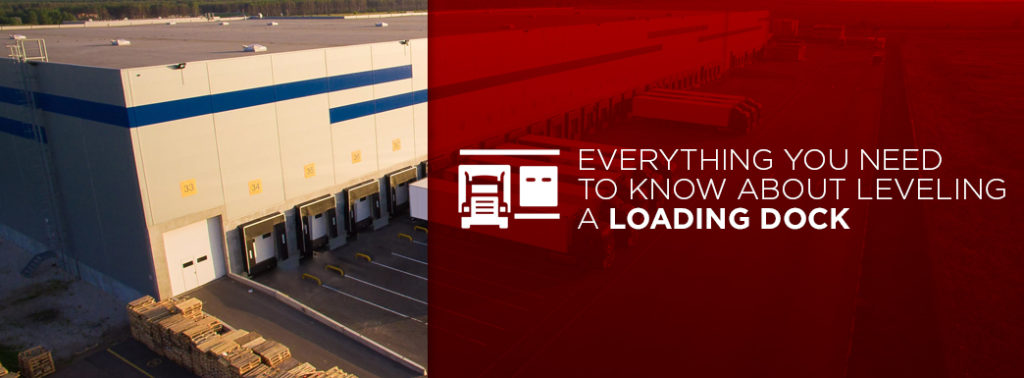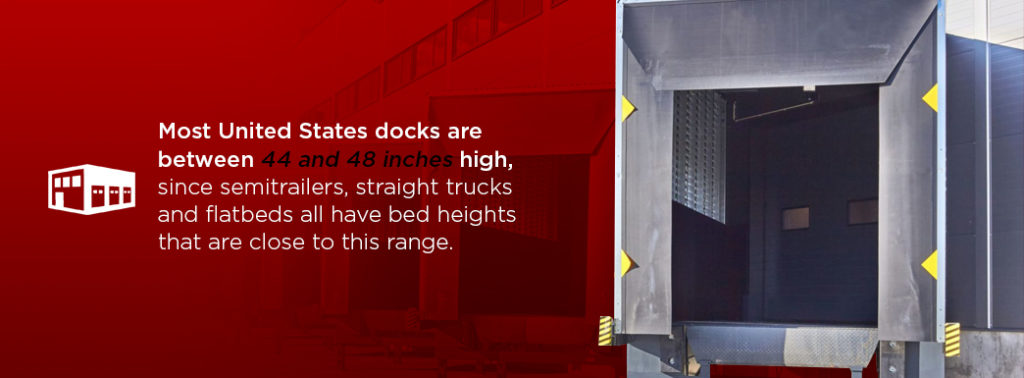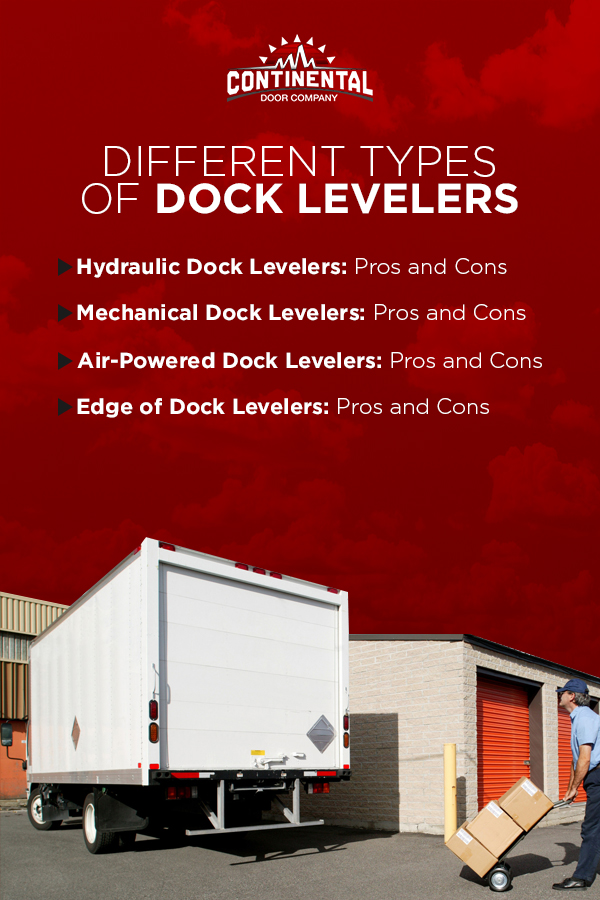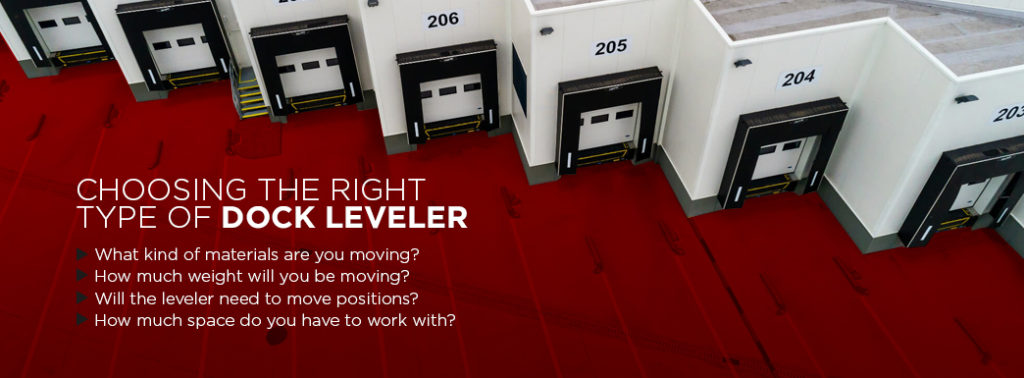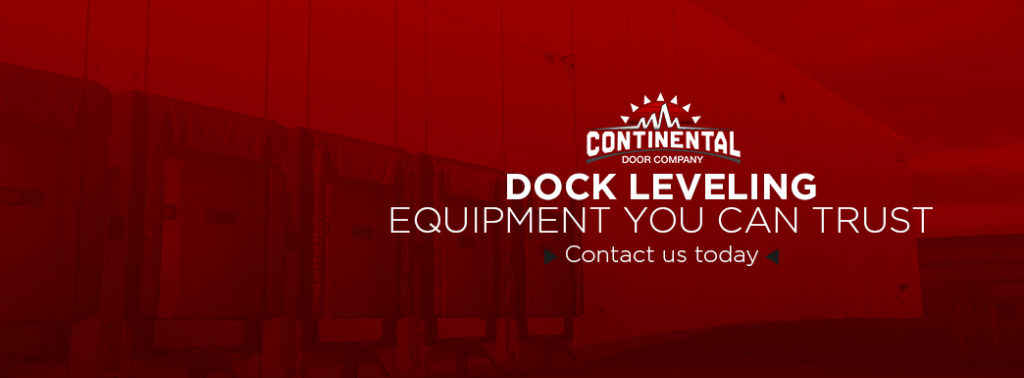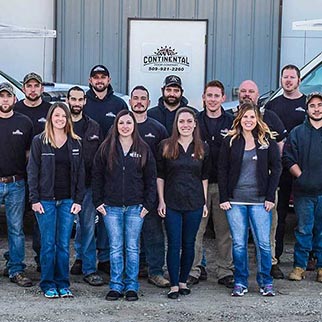What Is a Dock Leveler?
Your warehouse or dock has a lot of moving parts to it. One essential component of this bustling scene is a dock leveler. This handy piece of equipment bridges the gap between a vehicle and the warehouse floor, allowing industrial trucks and their cargo to be easily transported in a commercial space. Dock levelers are a must-have for most warehouse spaces, and even though the equipment might not be large, there’s still a lot to unpack here. Let’s dive in.
What Is a Loading Dock Leveler?
This height-adjustable platform is a popular way to easily transition between your vehicle and the dock. Since these two heights might not match perfectly, the dock leveler can be raised and lowered to meet the difference. This metal piece of equipment, comprised of several mechanical parts, is a popular way to increase efficiency, convenience and safety when using transportation in a warehouse.
What Is a Dock Leveler Used For?
A dock leveler is primarily used to enable industrial vehicles, such as forklifts, to maneuver in and out of docked trucks. This helps the loading and unloading process to happen safely and smoothly. Additionally, the adjustable feature of most dock levelers allows warehouses to service trucks of all sizes.
Parts of a Dock Leveler
A dock leveler consists of several different components. While they may vary depending on their type — whether they are hydraulic or mechanical — they’re comprised of similar parts. These include a core activation system, a frame and a shim. There are several built-in components for convenience and safety, including a toe guard, bumpers and a lip. The deck assembly is the metal part of the structure that is driven over by industrial vehicles.
Finally, the dock pit is the building’s floor opening that accommodates the dock leveler. Each of these parts works together to ensure a smooth and straightforward transition.
What Are My Dock Leveler Options?
When selecting a dock leveler, you’ve got a couple of different options to choose from. While they all accomplish the same end goal, they have different mechanisms and ways of doing so. The most common and popular options include:
- Hydraulic dock levelers: This type of leveler is stored in the dock pit and is known for providing the most seamless transition between vehicle and dock leveler. Thanks to its smoothness, it helps prevent injuries and minimize damage, leading to optimal safety. Its hydraulic lip and platform positioning makes it a reliable and low maintenance option to consider.
- Manual dock levelers: This version requires someone to manually control the leveler, pulling a chain that moves the deck from its stored position to the platform.
- Vertical storing dock leveler: Because of its upright storage position, this leveler allows the vehicle to dock fully before opening the trailer doors. This feature maximizes door protection, security and environmental control.
- Edge of dock (EOD) leveler: This leveler type is perhaps the simplest. Positioned on the edge of the dock, it works well for vehicles that have minimal height difference and allows warehouses to maximize on space because they don’t need to locate and move plates to the correct dock positions.
Purchase Commercial Dock Equipment From Continental Door Today
If you’re on the lookout for well-designed and reliable dock levelers in the Greater Spokane area, purchase yours from Continental Door today. We can connect you with hydraulic, manual and edge of dock levelers, as well as providing essential commercial dock services and equipment for your next dock project. Reach out to us today for a free estimate!
How to Choose the Right Dock Leveler for Your Dock
Choosing a Loading Dock Leveler
Dock levelers are a popular piece of equipment used to provide a transitional bridge between the dock and industrial vehicles. This allows other vehicles, like forklifts, to load and unload with ease and safety. While there are several styles of dock levelers, each of which offers its own unique advantages, they all complete the same essential function.
If you’re considering incorporating a dock leveler into your equipment list, you’ll want to think through a few factors before making your decision. The information below provides a few guidelines to help choose the right dock leveler for your warehouse dock.
Kinds of Dock Levelers to Consider
There are a few commonly-used types of dock levelers, each operating with unique variations. These dock leveler styles include:
- Hydraulic: Popular for its easy use and seamless vehicle-to-dock transitions, this portable dock leveler has many advantages. It contains a hydraulic cylinder that raises and lowers the deck, controllable with a push-button device for convenient operation. They’re generally versatile and require less maintenance than other types, explaining the higher cost.
- Mechanical: The most common loading dock choice, this leveler type operates with a mechanical spring that forces or restrains the leveler. It doesn’t require power to run and is generally cheaper than the hydraulic alternative — but runs up a higher bill in overall maintenance.
- Edge of dock (EOD): With no need for an installation pit, edge of dock (EOD) levelers are easy to operate and cost less than pit dock levelers. However, because they’re installed directly into the edge of a dock, they offer little versatility and limited range.
Which One Is Best For You?
To determine the best dock leveler for your needs and warehouse space, you must identify several different factors. All dock leveler types accomplish the same end goal. However, their style of operation, convenience and storage needs can differ widely. Consider these specifications before deciding which route may best fit your needs.
Price of Dock Levelers
Examine your budget and consider how much you are able to spend on your dock leveler. Each option is priced differently, with the hydraulic dock leveler’s price tag being the largest and the end of dock leveler generally the most affordable. This range of price tags has obvious reasons — including the levels of versatility, safety and efficiency, for example — but is certainly one to weigh before purchasing.
Dock Leveler Maintenance Cost
The initial cost of purchasing and setting up your dock leveler is just one number to consider. Like any piece of machinery, your dock leveler will likely need maintenance over time to ensure it continues working at maximum capacity. Neglecting its maintenance may lead to costly repairs or replacements down the road.
Hydraulic levelers, for example, typically cost more upfront but require less maintenance over time thanks to their design. Mechanical systems cost less, but they generally need more preventive care and service in the long run.
Dock Leveler Functionality
Depending on the operations of your warehouse, you may be using the dock leveler daily or multiple times a day. Consider how frequently it may be used as well as its functionality and ease of operation. It should be a device that your employees can learn to use easily as part of their daily tasks without slowing productivity.
Hydraulic levelers are popular because of their simple functionality, using push-button controls to move and modify the leveler. This keeps employees from exerting significant physical effort to use a leveler. If this is not something used frequently, however, you may be interested in considering the more budget-friendly manual option.
Dock Leveler Size and Load Capacity
Consider the size and shape of your dock space, as well as the kinds of vehicles you’ll be working with. Dock spaces with only a limited amount of room might benefit from an EOD leveler, whereas larger spaces could benefit from a more versatile option. If you’ll be using the leveler to support heavy loads, ensure it can handle the weight of its cargo. Consider the size and capacity of your warehouse dock and loads before settling on a certain leveler.
Order Your Dock Leveler From Continental Door Today
It’s a lot to consider, but once you’ve thought through the details and decided which leveler will work best for your budget, capacity, dock space and operational needs, you’re ready to purchase the right dock leveler. Continental Door is here to help make it simple. We can provide you with quality dock levelers — hydraulic, manual and EOD — as well as commercial dock services and equipment to get you ready for your next big project. Contact us today for a free estimate.
Everything You Need to Know About Leveling a Loading Dock
Loading docks are bustling centers of activity with a host of moving parts. A crucial piece in these exchange centers is loading dock levelers. Dock levelers are attached to a dock face or installed into a loading dock pit to bridge the gap between incoming vehicles and warehouses.
The importance of leveling a dock is multifaceted. Primarily, leveling allows industrial vehicles like forklifts to drive in and out of docked trucks quickly and safely — making the unloading process as efficient as possible. Dock levelers also adjust to reach up or down to different truck heights. This diversity enables the dock to service a wide range of trucks. If you’re working on a loading dock project or looking for the best way to level your docks, here are some things you should know.
Table of Contents
- Standard Dock Height in the United States
- Most Common Ways to Level a Dock
- Different Types of Dock Levelers
- Choosing the Right Type of Dock Leveler
- Importance of Quality Dock-Levelers
Standard Dock Height in the United States
Dock height plays an important role in the type of leveler you use and how safe your loading dock is. Most United States docks are between 44 and 48 inches high, since semitrailers, straight trucks and flatbeds all have bed heights that are close to this range. Some loading docks and some types of trucks, however, are outside of this height range. The beds of refrigerated trucks, for example, are typically between 50 and 60 inches tall, while city delivery trucks, high cube vans and panel trucks are typically shorter than 40 inches.
Consider the types of trucks your dock receives and find the midpoint of their bed heights. The goal for dock height is to minimize the inches between your dock and the trailers it serves. Dock levelers are great for bridging height gaps, but they work most efficiently when they are close to flat.
You’ll also need to consider whether the loading dock driveway approach will be level or have an inclined or declined ramp toward the building. Your dock driveway orientation affects trailer proximity to the dock wall in different ways:
- Level Driveway: The gap between the trailer and dock wall is the same from top to bottom.
- Inclined Driveway: The trailer is further away from the dock wall at the top and closer at the bottom.
- Declined Driveway: The trailer is closer to the dock wall at the top and further away at the bottom. If improperly configured, this type of driveway can cause dock wall collisions.
In a declined driveway approach, if your driveway slope is too steep and the dock has inadequate bumper projections, truck tops may hit the building while docking. This is a serious safety concern for both the dock structure and trailer.
To avoid trailer and dock wall collisions, ensure that the declined driveway slope and projection of the dock are such that trailer tops are always at least four inches away from building walls. Creating an even surface for forklifts to drive across will keep workers safe and allow the dock levelers to perform effectively.
Most Common Ways to Level a Dock
The most common kinds of dock levelers are designed to fit into some form of dock pit. When leveling a dock, there are three main ways to create this pit. Builders may choose to begin with a preformed pit, use a pour in pan method or utilize a pit kit. Each method has pros and cons based on your timeline, building plans and preferences.
1. Preformed Pit Method: Pros and Cons
The preformed pit method involves constructing and reinforcing pits for dock levelers in the dock building process.
Pros of a preformed pit include:
- Perfect Fit: When using a preformed pit, you know your pit will be the right size for the type of leveler you’ve selected.
- Convenient: You won’t need to adjust your dock in any way before installing the leveler. Once the pit is constructed, you can add the leveler.
Cons of a preformed pit include:
- Necessary Forethought: Not everyone has the luxury of starting with a new loading dock. The preformed pit method is suited for those in the dock-construction phase. You also have to know what type of leveler you want to install to size the pit correctly. This amount of forethought may be tricky depending on how much you know about the dock before it is set into action.
- Longer Installation: While you are all set to install the leveler right away, waiting for the pits to be constructed can take a long time.
2. Pour in Pan Method: Pros and Cons
Pour in pan installation methods come with a pan that serves a pit. The pan is welded to the dock leveler, making the installation a quick process.
Pros of a pour in pan pit include:
- Reduced Installation Time: Installing a pour in pan leveler is as simple as placing and centering the leveler and pouring concrete around the outside to secure it. This process is simple and ideal for docks installing multiple levelers at once.
- No Preformed Pits: Because pour in pan levelers function as their own pits, you don’t need precisely measured pits. This versatility eases the installation process.
Cons of a pour in pan pit include:
- Required Preparation: For pour in pan levelers, you still need to ensure there is a notch cut in the foundation wall to give the leveler a place to sit. In addition, you need a concrete slab for each leveler to sit on.
3. Three-Sided Pit Kit Method: Pros and Cons
Three-sided pit kit levelers come with pre-made steel panels that are fastened together on-site.
Pros of a three-sided pit kit include:
- Perfect Size: Because these pits are assembled on-site, you are guaranteed to have the right-sized pit for your leveler.
- Reduced Cost: Using a pit kit costs less than traditional wood forms.
Cons of a three-sided pit kit include:
- Minimal Customization: Because these kits are pre-fabricated, it may be difficult to customize other features of your dock.
Different Types of Dock Levelers
Once you’ve established a dock pit, you can begin selecting a type of dock leveler. There are several dock leveler varieties, and each provides certain advantages depending on your situation. In general, dock levelers are operated with electrically-powered push-buttons or with spring-loaded mechanics. Push-button models tend to be easier to operate and are more ergonomic — however, they may not be the best choice if your dock doesn’t have nearby electrical outlets.
Here is a breakdown of each leveler type and its pros and cons:
1. Hydraulic Dock Levelers: Pros and Cons
Hydraulic dock levelers get their name from the hydraulic cylinder that raises and lowers the deck and operates the lip.
Pros of a hydraulic dock leveler include:
- Versatility: A hydraulic dock leveler comes in a variety of configurations and has several power options.
- Economic: These types of levelers tend to have lower service and maintenance costs overall.
- Push Button: Hydraulic levelers are push-button enabled, making them safe and easy to operate.
Cons of a hydraulic dock leveler include:
- Initial Cost: Hydraulic dock levelers are usually more expensive than other types.
- Electricity: This dock leveler requires a power source nearby and will contribute to your overall electric bill.
2. Mechanical Dock Levelers: Pros and Cons
Mechanical dock levelers tend to be the most common choice for loading docks. Mechanical spring systems force the leveler upward or restrain the leveler depending on its position.
Pros of a mechanical dock leveler include:
- Initial Cost: Mechanical dock levelers are among the least expensive options for dock leveling.
- Powerless: Because these levelers don’t use electricity, you don’t need to worry about having a nearby power source or an increased electricity bill.
Cons of a mechanical dock leveler include:
- Expensive Upkeep: These levelers are typically the most expensive to repair and maintain long-term.
- No Push Button: Workers position mechanical dock levelers manually.
3. Air-Powered Dock Levelers: Pros and Cons
Air-power dock levelers use a pneumatic bag system to move the leveler deck.
Pros of an air-powered dock leveler include:
- Inexpensive Upkeep: When compared to mechanical dock levelers, air-powered levelers are less expensive to repair and maintain and require less overall upkeep.
- Push Button: Air-powered levelers are push-button enabled, making them safe and easy to operate
Cons of an air-powered dock leveler include:
- Initial Cost: Air-powered dock levelers are more expensive to purchase than mechanical dock levelers.
- Electricity: Some electricity is required to power the airbag system in an air-powered leveler. You’ll need a nearby power source, and these levelers will add to your electric bill.
4. Edge of Dock Levelers: Pros and Cons
Edge of dock (EOD) levelers do not always require an installation pit. As their name indicates, these levelers are installed directly into the edge of a loading dock.
Pros of an EOD leveler include:
- Initial Cost: EOD levelers cost significantly less than pit dock levelers
- No Pit Required: If your loading dock doesn’t have any pits, you can install an EOD that doesn’t require a pit.
- Push Button: EOD levelers are push-button enabled, making them safe and easy to operate
Cons of an EOD leveler include:
- Electricity: EOD’s use hydraulic or pneumatic power, which means you’ll need an electricity source nearby, and you’ll pay for them on your electric bill.
- Limited Range: An EOD has a limited vertical operation range, which means it may not be safe to use them unless the vehicles you typically service are close to the loading dock height.
Choosing the Right Type of Dock Leveler
With so many options available, how can you know what type of dock leveler is best for you? The most significant influence over your leveler choice will be your specific loading dock situation. In some scenarios, “cons” listed for each leveler may actually be “pros.” Understanding how your dock functions will give you a clear idea of what to look for in a dock leveler.
Here are some details to consider:
What kind of materials are you moving?
Materials transported through the dock will make an impact on the type of equipment traveling over your leveler. Light materials may be transported manually, meaning the dock leveler will only have to support human weight plus material weight. Heavier materials may be transported by forklift. This means your leveler will need to be strong enough to safely support the specific forklifts driving over them in addition to the material weight.
How much weight will you be moving?
Your materials and transportation method will determine the amount of weight traveling over your dock leveler. According to industry group MHI, over 90% of dock levelers have a weight capacity range of 25,000 to 80,000 pounds. In any case, you’ll want a dock leveler that caters to the heaviest materials and equipment you’ll be transporting. Once a dock leveler is installed, you can’t add weight capacity to it. Be sure to give yourself enough capacity to account for the potential of heavier equipment or materials in the future.
Will the leveler need to move positions?
If your dock services a wide range of vehicle heights, you’ll need a leveler that can reach up or down to them. In this scenario, an EOD leveler may not provide the necessary range, and you may want to opt for a pit leveler. If your dock leveler consistently needs to be positioned at an incline or decline, you might need to pick a leveler with more capacity. The greater the degree of incline in your leveler, the greater the impact your equipment will have on it. If your dock experiences a variety of vehicle heights, you’ll want to pick a leveler with the versatility to service them all safely.
How much space do you have to work with?
The loading dock’s space availability may impact your dock leveler selection. Preexisting docks with limited space may want to pick a space-efficient EOD leveler. Docks with more space may enjoy the versatility of a pit leveler. Make sure you match your space requirements with your weight and function requirements when making a selection. If you’re a contractor designing or building a loading dock, be sure to give ample space for the type of dock levelers your clients need.
Other considerations:
Price of dock levelers
Examine your budget and consider how much you are able to spend on your dock leveler. Each option is priced differently, with the hydraulic dock leveler’s price tag being the largest and the end of dock leveler generally the most affordable. This range of price tags has obvious reasons — including the levels of versatility, safety and efficiency, for example — but is certainly one to weigh before purchasing.
Dock leveler maintenance cost
The initial cost of purchasing and setting up your dock leveler is just one number to consider. Like any piece of machinery, your dock leveler will likely need maintenance over time to ensure it continues working at maximum capacity. Neglecting its maintenance may lead to costly repairs or replacements down the road.
Hydraulic levelers, for example, typically cost more upfront but require less maintenance over time thanks to their design. Mechanical systems cost less, but they generally need more preventive care and service in the long run.
Importance of Quality Dock-Levelers
Use the answers to these questions to help narrow your leveler selection. To ensure proper loading dock leveler safety, navigate the selection process with long-term consequences in mind. Though the initial cost of certain leveler types may prompt you to consider a less expensive option, loading dock safety should be a top priority.
In line with industry trends and best practices, many companies are choosing safe, long-lasting dock equipment rather than low-cost equipment. Certain high-cost levelers require less overall maintenance, making them a quality investment. Don’t let cost drive your leveler selection. Instead, focus on finding a safe, functional option with the longevity to serve your facility well.
Dock Leveling Equipment You Can Trust
Leveling a loading dock is a serious task. When you’re shopping for dock levelers, you want a high-quality solution that fits your needs. At Continental Door, we’re committed to finding those solutions with our excellent products and outstanding customer service. Shop our selection of loading dock essentials for safe, effective equipment that maximizes your dock’s productivity.
Contact us today to learn more about our loading dock equipment or to request a free estimate for your project!
Contact UsRequest More Information About Dock Leveling Equipment
Related Posts
Tips for Improving Loading Dock Safety Everything You Need to Know About Automated Security Gates Keeping Your Employees Safe from Your Commercial Garage Door What Should You Be Looking for in a Commercial Garage Door?
3 Signs You Need to Replace Your Dock Leveler
Signs it’s Time to Replace Your Loading Dock Leveler
When your business operates out of a loading dock, you know just how important it is to perform regular loading dock maintenance. Doing so is an investment in safety for your most valuable asset — your personnel.
But how do you know when it is time for dock leveler repair or replacement?
What Is a Dock Leveler Used For?
Levelers are used in buildings with truck-level doors. In terms of safety, a dock leveler is one of the most essential parts of a loading dock.
A dock leveler is a height-adjustable platform generally made from a large metal plate. The dock leveler bridges the gap between the loading dock and the truck. It can be raised or lowered depending on the height of the truck’s bed.
While a dock leveler is a sturdy piece of equipment, it can be worn down over time when subject to heavy forklift traffic. Dock leveler repair can help, but replacement is necessary from time to time.
Reasons for Dock Leveler Replacement
The following signs indicate that it may be time to replace a dock leveler:
1. The Components are Warped
The weight and stress of constant forklift traffic can warp elements of a dock leveler over time. If the dock leveler is visibly warped, repairs will probably not be effective — it is most likely time for a replacement.
2. You Want to Upgrade the Door or Bay
There may be a number of reasons to upgrade the door or bay of a loading dock. Maybe the components are damaged or outdated, resulting in a decrease in efficiency. If this is the case, the dock leveler is one of the parts of a loading dock that should probably be replaced.
3. The Leveler Is Outdated, Unsafe or Fails to Meet Leveler Requirements
A dock leveler can be outdated or unsafe for numerous reasons. Even with regular loading dock maintenance and dock leveler repair, this device can wear down over time like any other equipment. An unsafe dock leveler can result in damage to forklifts and cargo as well as serious injuries to personnel. Replacement of an unsafe dock leveler protects your business’s most valuable assets.
When to Upgrade a Dock Leveler
The reasons for dock leveler repair and replacement come down to two main factors: safety and efficiency. Ideally, you’ll upgrade the dock leveler before any safety concerns arise.
Monitoring efficiency can be a useful way to determine when it is time for an upgrade. When a dock leveler is outdated or unsafe, operators require more hands-on time with equipment to ensure safety. Over time, this results in more downtime and a decrease in production.
If you notice that production is gradually getting lower, it may be time to upgrade the dock leveler.
How Often Should a Dock Leveler Be Serviced?
The type of leveler used in your loading dock can impact the amount of service it requires. Some designs just aren’t built to last as long as others.
Mechanical levelers generally last five to seven years, while hydraulic levelers might last 10 years.
Yearly service is the best way to ensure that a dock leveler is in proper working order.
Contact Continental Door Today
The leveler is one of the most essential parts of a loading dock, so dock leveler repairs and replacements are important investments in the future of your business’s operations. If your leveler is warped, worn or part of an outdated bay, trust Continental Door to perform the expert repair or replacement you need to keep your business moving.
Contact Continental Door for high-quality and professional services and expertise. We are proud to serve homeowners and businesses in the Greater Spokane area. Request an estimate or service today.

